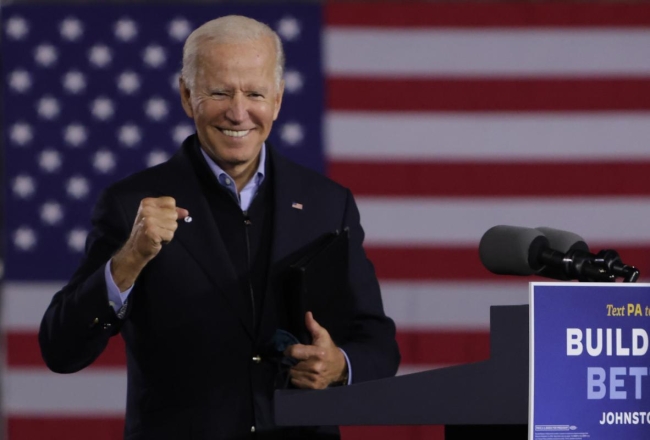You have /5 articles left.
Sign up for a free account or log in.

Alex Wong/Getty Images
President Joe Biden’s American Families Plan is a game-changer for community colleges and minority-serving institutions, campus leaders say. The $1.8 trillion plan, proposed Wednesday, could bring a much-needed windfall to institutions serving students most hard-hit by the COVID-19 pandemic.
The plan is a grab bag of opportunities for open-access institutions. It dedicates $109 billion toward two years of free community college and $39 billion for two years of tuition at minority-serving institutions for students with a household income of less than $125,000. It also invests $62 billion for “completion and retention activities at colleges and universities that serve high numbers of low-income students” and allocates $80 billion to increase the maximum Pell Grant by $1,400 per student.
Biden has “really gone big -- I mean, for real,” said Walter Kimbrough, president of Dillard University, a historically Black institution in New Orleans. Kimbrough, who was also president at Philander Smith College in Arkansas, hasn’t seen a proposal from a president that invests as much in minority-serving institutions, especially HBCUs.
"He's really making some strong statements about the value of education and investing in young people," he said.
Higher education leaders were particularly heartened by Biden's plan to boost the Pell Grant, even if the maximum amount of the federal financial aid grant, currently $6,495, wasn’t doubled as many had hoped.
Across HBCUs, about two-thirds of students are Pell eligible. Nearly 75 percent of the students at Dillard are eligible.
The proposed funding in the Biden plan comes at a time when the financial status of long-struggling minority-serving institutions in general, and HBCUs in particular, is getting widespread attention. Public awareness of racial, economic and educational inequities has been increasing as part of the country's racial reckoning since the killing of George Floyd. Policy makers and philanthropists alike have moved to address these issues and support institutions that educate large numbers of students of color.
Congress allocated $1.05 billion in emergency aid to minority-serving institutions, with a little over half of the funding going to HBCUs, as part of the CARES Act legislation passed last year in response to the pandemic. These institutions also received a portion of the $12.2 billion stimulus funding that went to all colleges and universities.
Congress also passed the FUTURE Act in 2019, which made permanent $255 million in annual funding to minority-serving institutions, with about $85 million allotted specifically to HBCUs. Former president Trump boasted that he “saved” HBCUs by signing the bill, but Kimbrough said Trump’s support for HBCUs was “performative” and mainly about branding.
Kimbrough said the attention the American Families Plan pays to HBCUs signals deeper investment and is part of a broader moment in the spotlight for the institutions. The universities recently saw their visibility rise as HBCU graduates Vice President Kamala Harris, a Howard University alumna, and U.S. Senator Raphael Warnock, a Morehouse College alumnus, took office this year.
Others have also taken notice of the work of HBCUs -- they collectively educate 20 percent all Black undergraduates -- and the many needs of these institutions, which tend to have small endowments and be highly reliant on enrollment. Philanthropist MacKenzie Scott, the ex-wife of Amazon founder Jeff Bezos, recently gave 23 HBCUs multimillion-dollar gifts. Reed Hastings, co-founder and CEO of Netflix, gave Spelman College, Morehouse College and the United Negro College Fund a total of $120 million.
“Now you see a disproportionate number of HBCU graduates who are part of the conversation about where we go as a nation,” Kimbrough said.
Keith Curry, president and CEO of Compton Community College, is also thinking about next steps. He sees Biden’s proposal as an opportunity for his institution to build more partnerships with historically Black colleges and universities so eligible students transferring from his institution can take advantage of the two years of subsidized tuition.
He's asking himself and his colleagues, “How can we encourage more students to look at HBCUs?” he said. “How do we engage more of the HBCUs in the work that we’re doing on our campus, so they can be able to interact with our students and talk about the programs and services they provide?”
The combination of free community college, paired with two subsidized years at a minority-serving institution, would be impactful for Latinx students, too, said Antonio Flores, president and CEO of the Hispanic Association of Colleges and Universities. He pointed out that about 40 percent of Hispanic-serving institutions are community colleges, and more than half of Latinx students start their college careers at two-year institutions. So free community college will especially benefit this population.
“Unfortunately, many of them don’t make the transition to four-year degree programs,” Flores said. “We hope that this will help them because it will not push them to accumulate debt and, in many ways, not feel burdened by the financial side of things.”
But while excited by the possibilities, some campus leaders worry their institutions will be left behind by the new proposal.
Carrie Billy, president and CEO of the American Indian Higher Education Consortium, thinks the plan is a well-intentioned “step in the right direction” but doesn’t properly account for the unique situation of tribal colleges and universities.
For example, she said only three or four tribal colleges offer four-year degrees, and one of them is already tuition-free. So most tribal colleges won’t benefit from the $39 billion toward subsidized tuition for low-income students at four-year minority-serving institutions.
“We shouldn’t be compared to each other,” Billy said. “Each institution -- tribal colleges, HBCUs, HSIs -- need to be looked at as separate groups of institutions and their needs addressed.”
Since tribal colleges are predominantly two-year institutions, free community college could help their students, but Billy wants more details on who would foot the bill. The pandemic revealed the deep financial challenges facing tribal communities; she worries the plan might call on tribes to pay a share of the tuition.
“It’s tremendously sad it took a pandemic for people to pay attention to the fact that our people, our lands, our institutions don’t have access to even basic resources in this country,” she said.
Larry Galizio, president and CEO of the Community College League of California, which represents campus leaders in the state community college system, called the Biden proposal a “transformative shift in policy” after decades of underfunding for underresourced institutions. He also views it as a beginning step, however.
“It’s not enough money over the long haul,” he said. “You can’t make up for 50 years of disinvestment in one fell swoop, but it’s a strong message and down payment on shifting policy.”
Community college enrollments have plummeted over the past year as the pandemic strained institutional budgets and the economic downturn upended the lives of many students. Enrollment fell 11.3 percent this spring compared to spring 2020, according to the latest National Student Clearinghouse Research Center data. In addition to making higher education more affordable, Biden’s plan could elevate the visibility of community colleges at a time when the institutions are struggling to retain students, said Galizio. The California Community College system lost at least 186,688 students in fall 2020. He hopes the lure of free community college might encourage them to re-enroll.
“I think it absolutely increases the chances that we won’t have this lost generation that have suffered disproportionately both in health and employment,” he said.
Biden’s inclusion of Dreamers, undocumented immigrants who were brought to the U.S. as young children, in the free community college plan was “very important” to California community colleges, he added. Roughly 72,000 undocumented students are enrolled in the system’s 116 institutions.
But Galizio also worries the free community college plan might not account for “institutional capacity.” He wants to make sure that, with an influx of students, colleges actually have the resources they need to support them.
Donald Guy Generals, president of the Community College of Philadelphia, said nontuition costs for his students are also a concern.
“Community colleges like ours often enroll and support large shares of Black, Hispanic and Latin-X students -- many who are low-income and require additional support to ensure that they succeed,” he said in a written statement. “Any plan to make community college more accessible must include funding dedicated to overall student success, such as funding to cover the cost of books, and access to resources like housing assistance and child care, as well as funding to provide enhanced academic success and career coaching.”
Nonetheless, both Galizio and Generals, like many other campus leaders across the country, support the American Families Plan and believe in its potential to have a meaningful impact on the lives of poor students and students of color -- and they remain hopeful it will pass.
Curry wants to be ready if or when it does pass. He’s already brainstorming ways to advertise the increased Pell Grants to his students and devising recruitment and retention strategies that could fall under the grant program proposed in Biden's plan. If the proposal passes, he thinks it's up to campus leaders to use the money to invest in long-lasting student support structures so these funds aren't just a "one-off" benefit but rather a transformative moment for higher education.
“I don’t think we’ll get another opportunity like this,” Curry said. “Now there are resources available. Now what are we going to do to transform our organizations and meet the needs of students?”









